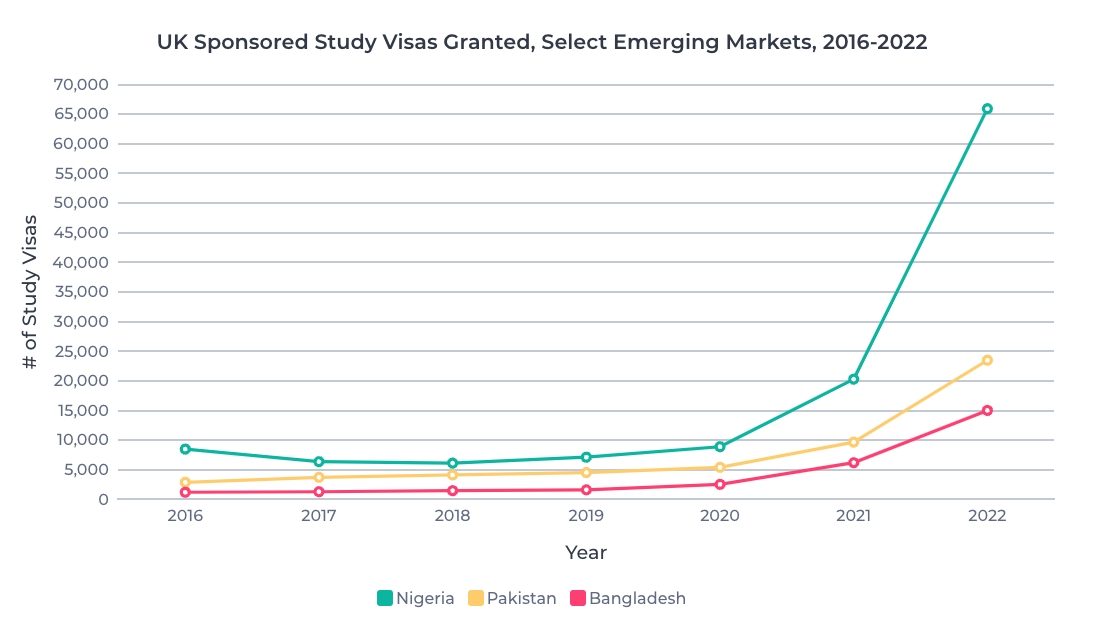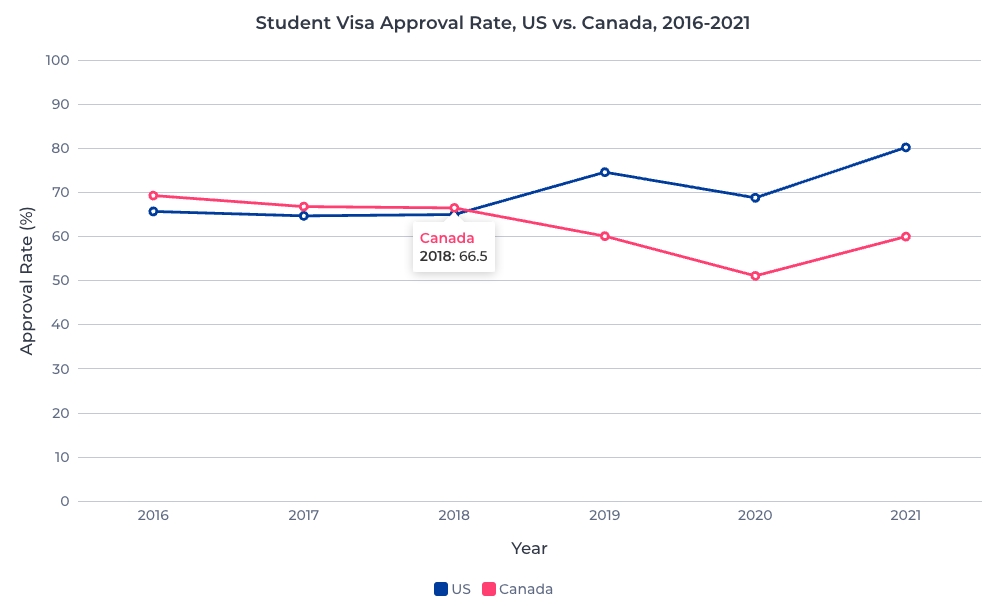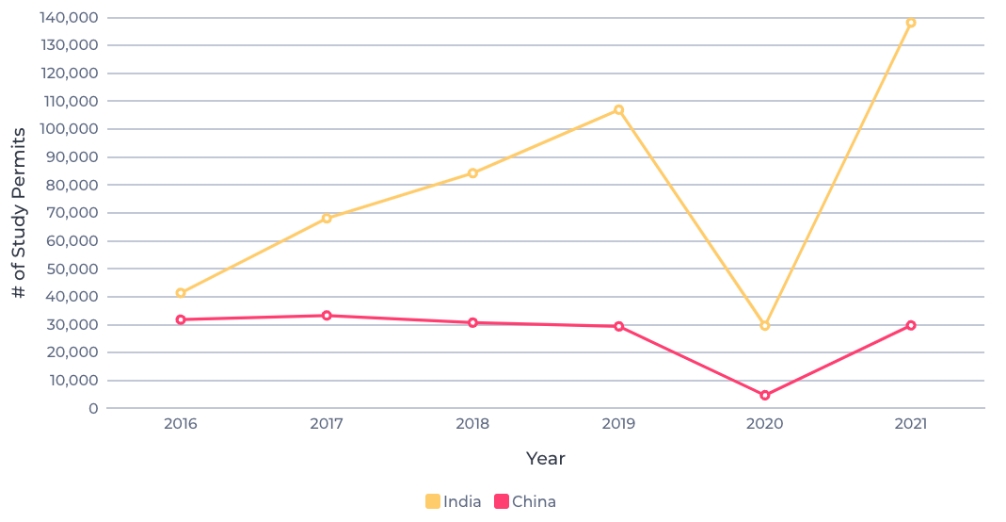Strong International Education Rebound in 2021–2022
In 2021, the Canadian government processed more than 550,000 new student visa2 applications,
easily surpassing the record 425,000 processed in 2019.3 2022 is primed to smash 2021’s numbers,
with more than 450,000 applications already processed through the end of August.4
The United Kingdom has seen a similar boom. Nearly 450,000 students applied for a sponsored study
visa in 2021, up from 290,000 in 2019. And another 140,000 applications were submitted in the
first half of 2022, 80% more than in the same period last year.5
On the Uniwolc Platform, there was a 250% rise in UK applications
submitted between January and September 2022 compared to the same period in 2021.
Australia’s borders remained closed to international travel until mid-December 2021. Though there
were concerns its international education sector would be slow to recover, early signs are
positive. More than 213,000 Australian student visa applications were lodged from January to
August 2022, almost 25% more than the same period in 2019.6
If there’s a laggard among the top English-language destination markets, it’s the United States.
The US government processed just under 450,000 student visa applications for its 2021 fiscal
year,7 below the nearly 490,000 processed in fiscal year 2019. But 2022 may be more promising.
At Uniwolc, US applications spiked by 200% from January to September 2022 compared to the same
period last year.
Processing Delays Leave Students in Limbo
So many students vying to study abroad has put strain on the international education ecosystem.
Governments have struggled to manage the influx of applications, leading to processing delays
that have kept students in limbo for months and, in some cases, forced them to defer their
studies.
Canada’s total visa backlog reached 2.1 million in June, due in part to the Canadian government’s
efforts to relocate refugees from the Ukrainian crisis.8 Amid this backlog, average student visa
processing times hovered between 11 and 13 weeks throughout 2022 after falling as low as seven
weeks in 2021.9 And for certain countries, processing times have been much higher. For example,
processing times for Sri Lankan students reached 26 weeks in September.
In the US, estimated wait times for a student visa interview appointment climbed steadily over
the course of the year before falling sharply in September. But like Canada, significant
outliers remain. Remarkably, wait times of over a year remained for select Indian cities in
October. The US government authorized consular officers to waive the in-person requirement for
category F visa applicants through the end of 2022, but applicants must meet specific criteria
to qualify for a waiver.10
Facing its own visa processing delays, the UK government pointed to its own efforts to support
Ukrainian refugees as contributing to the backlog.11 In June, the British High Commissioner to
Nigeria implored applicants to apply for their study visa well ahead of when they might have in
previous years.12 In August, the government restored certain priority visa services, suspended
without warning in March, allowing students to pay a premium for faster visa turnaround times.13
By October, average processing times for UK study visas sat at
three weeks—significantly less than those for the other major English-language
markets.
Australia Faced Backlogs Of Five To Nine Months While Its Borders Were Closed.14 However,
The Australian Government Has Made Significant Investments To Expedite Visa Processing,
Adding 140 New Staff In May.15 Currently, The Government Advises Students To Lodge Their
Applications At Least Six To Eight Weeks Before Course Commencement.
The Australian government’s willingness to invest in better visa processing is an encouraging
sign for the sector. While the post-COVID boom will not last indefinitely, the ability to
deliver shorter visa processing times—as we’re currently seeing from the UK—is likely to be a
key point of competitive differentiation across markets moving forward. International students
are eager to begin their education abroad as soon as possible, particularly those who put their
plans on hold during the pandemic.
Student Visa Approval Rates a Key Differentiator
For some international applicants, the long wait for visa processing ends in disappointment. This
is less of a concern in the UK and Australia, where candidates less likely to secure a visa are
typically triaged out at the institution stage, and government approval rates are upwards of
90%.
For Canada and the US, however, significant numbers of students are refused a student visa. From
2016 to 2018, approval rates for Canadian and US students visas were roughly on par, hovering in
the mid to high 60s. But since 2019, US approval rates have been consistently higher than
Canadian rates. In 2021, the US F-1 student visa approval rate hit 80%, its highest since 2013.
Canadian students, meanwhile, had just a 60% approval rate in 2021, and that rate fell to 57%
over the first six months of 2022.
Students have taken notice of these challenges. In the October edition of Uniwolc Pulse Survey,
66% of recruitment professionals surveyed said that visa processing times and approval rates
were a top concern for their students. US institutions would be well served to highlight this
advantage over their counterparts in Canada as they continue to rebuild their international
enrollment post-pandemic.
Affordability, Post-Graduate Work Top Concerns Among Students
A global recession looms over many economic projections for 2023. In October, the International
Monetary Fund (IMF) revised its global growth forecast for next year to 2.7%, down 0.2
percentage points from its summer projection.16 The 2023 forecast is the weakest growth profile
since 2001 except for the global financial crisis and the acute phase of the COVID-19
pandemic—arguably the two largest periods of financial uncertainty within the past 20 years.17
A new study from the World Bank Group also suggests that the global economy is edging toward a
recession in 2023, and that a string of financial crises could create lasting damage to key
markets.18
“Global growth is slowing sharply, with further slowing likely as
more countries fall into recession. My deep concern is that these trends will persist, with
long-lasting consequences that are devastating for people in emerging markets and developing
economies.”
— David Malpass, President, World Bank Group
Affordability Concerns Paramount with Recession Looming
Against this global economic backdrop, Uniwolc Pulse Survey asked counsellors what aspects of
studying abroad their students were most concerned about when choosing where to study.
Affordability issues dominated the results. More than 85% of respondents cited cost of studying
as a concern for their students. This was the most commonly occurring concern, followed by
post-graduation work opportunities (80%) and cost of living (73%). These results are
unsurprising, as high inflation and rising interest rates have dominated financial news around
the world throughout 2022.
Surveys of prospective international students have produced similar results. Across four of five
priority markets for US institutions, students indicated that cost of living was their number
one concern about studying abroad.19 Similar results held for the UK20 and Canada.21 For
Australia and New Zealand, four out of the top five worries students expressed about studying in
a different country are related to affordability. Cost of living (74%) was number one, followed
by availability of scholarships (65%), safety (55%), getting a job (49%), and finding
accommodations (49%).22
Uniwolc exclusive internal data also reflects the concerns students have about the affordability
of studying abroad. In 2019, 60% of searches on the Uniwolc Platform were for programs with
tuition fees of over 50,000 per year.23 But by 2021, this fell to 29%. Student willingness to
spend is up slightly in 2022. Even so, two out of every three students on our platform searched
for tuition fees below 50,000 per year. In short, even as students are once again on the move in
large numbers, they remain less willing (or able) to pay high tuition fees today than they did
before the onset of the pandemic.

How do these widespread concerns about affordability affect destination market competitiveness?
Uniwolc Pulse Survey asked counsellors which major English-language destination markets were
more attractive from an affordability standpoint. Canada was the clear winner, with 87% of
respondents saying they felt that studying and living in the country was affordable for
international students. Canadian institutions should consider highlighting this
advantage—particularly those located in more affordable regions of Canada, such as the Prairies
and Atlantic provinces.
Strength of American Dollar Will Impact Affordability
Another macroeconomic trend impacting the international education ecosystem? The soaring value of
the American dollar. Shockingly, the euro fell below parity with the USD in August.24 The US
Dollar Index—which measures the value of the dollar relative to six other major foreign
currencies—reached highs in 2022 not seen since the turn of the century. While a strong US
dollar is good news for traveling Americans and students already living and working stateside,
it also means that newer students relying on personal savings may find their home currency no
longer goes as far in the US as it once did.
This currency shift means that American institutions and policymakers will need to monitor their
market closer than ever before. There is a strong opportunity for the sector to grow its
reputation for supporting students through these tough financial times by offering scholarships.
At the same time, competing destination markets like Australia and Canada could leverage the
strong USD to appeal to students who find their budgets suddenly unable to accommodate the
shifting currency value. Likewise, with the euro falling below parity with the USD and the
British pound potentially not far behind,25 the EU and UK may be more affordable destinations
than before. As the only Anglophone country remaining in the EU, Ireland seems likely to be a
major beneficiary.
For more on how the rise of the American dollar will impact
global student mobility, read the Uniwolc data blog, ApplyInsights.
Post-Graduation Work Opportunities an All-Important Driver
Post-graduation work opportunities remain a key consideration for students choosing between
destination markets. As mentioned above, 80% of our recruitment partner network indicated that
post-graduation work opportunities are a top consideration for their students. Other surveys
have found that nearly half of all students intend to stay in their destination market to work
after graduation.26
With post-graduation work opportunities of such paramount importance to students, the generosity
of these programs offers a key opening for destination markets to get a leg up on the
competition.
Canada’s Post-Graduation Work Permit Program (PGWPP) allows international graduates to stay and
work in Canada for eight months to three years, depending on the length of their study program.
The PGWPP is particularly highly regarded.27 When surveyed, 97% of Uniwolc recruitment partners
agreed that Canada provides strong post-graduation work opportunities for their students.
The program’s sky-high approval rate may be a factor. More than 97% of eligible PGWPP applicants
were approved between January of 2016 and July of 2022.
Please rate your level of agreement with the following statement:
This country provides strong post-graduation work opportunities for my students.
In Australia, the Post-Study Work stream allows international students who’ve recently graduated
with a degree from an Australian institution to live, work, and study in Australia for two to
four years, depending on their qualification.28 However, the Australian government announced in
September that graduates in select sectors will be eligible to stay and work for an extra two
years.29 This change makes Australia’s post-graduation work program the most generous among the
four main English-language destination markets, and may well push Australia ahead of its
competitors when it comes to attracting international talent.
The introduction of the Graduate Route (GR) in the UK helped propel international student
enrollment growth by 8% in 2020/21.30 Incredibly, this helped the UK reach its 2030 goal for
international student enrollment nine years ahead of schedule. And there’s room for even further
growth: in student surveying, nearly 60% of prospective students said they would be more likely
to consider studying in the UK if international students could remain in the country for three
years instead of two.31
The US trails other markets with respect to post-study work rights. The Optional Practical
Training (OPT) program extends for just one year for most students, with science, technology,
engineering, and mathematics (STEM) students eligible for a two-year extension. Beyond this, the
transition from OPT to a permanent residency pathway is a particularly difficult one.
Nevertheless, OPT is well subscribed, with more than 200,000 international graduates working
under the program in the 2021 academic year.32 In January, the Biden administration took steps
to make OPT more accessible to international students by making 22 additional STEM sub-fields
eligible for the two-year OPT extension.33
When I was considering which country to study in, the countries
where I had a path to staying long-term after graduation were the ones I found most
attractive.
— Joseph, Nigerian International Student
Destination Markets Alleviating Work Barriers for International Students
The expansion of post-graduation work opportunities is exciting to see. But new and current
students often need to work part-time to pay for their tuition and living expenses. How
destination markets support these efforts is another key area of differentiation.
The Canadian government recently lifted the 20-hour weekly limit for international students
authorized to work off-campus.34 There are more than half a million international students in
Canada, and this change will not only help increase their weekly income and alleviate cost of
living pressures, but also increase their work experience and possibly help prepare them for
later career success.35
These policy changes are sure to be welcome news for students,
their parents, and employers across Canada, making it an important improvement that will
keep Canada top of mind for international students and competitive as a nation looking to
attract top talent.
— Meti Basiri, Co-Founder and CMO, Uniwolc
Like Canada, Australia has temporarily relaxed the working hours cap for student visa holders.
But this relaxation will end on June 30, 2023.36 This means that working hours will once again
be capped for students following this date. In the UK, international students are capped at 20
hours of work per week during the school term.37 The US also caps working hours for
international students at 20 hours per week.38 Although Canada’s relaxation of its working hours
cap is scheduled to end on December 31, 2023, these changes should boost the country’s
reputation as accommodating to student needs, thereby giving the country a competitive
recruitment edge over other destination markets over the next year.
Global Need for Workers Driving Competition for International Students
If destination markets are expanding post-graduation work opportunities, does that mean
international students are well positioned to fill gaps in the job market? Job vacancies reached
record levels while unemployment rates fell to multi-decade lows nearly across the board in
2022.39 This means that organizations experienced a growing need for workers, but faced a
shrinking pool of available talent to hire. While this trend will likely shift in 2023 due to
the looming recession, for many high-skill positions, student recruitment should remain a vital
component in filling those roles.
This is perhaps most evident in the healthcare industry. Tragically, the World Health
Organization (WHO) estimated that between 80,000 and 180,000 health and care workers lost their
lives due to COVID-19 between January 2020 and May 2021, a figure that has likely risen in the
year and a half since.40 Other healthcare workers have sought out new sectors for employment.
These losses have contributed to a global crisis in which nations face a shortage of healthcare
workers.41 Recruiting professionals from one country to another will not solve this
crisis—instead, new workers need to be trained.
Encouragingly, this need may be starting to reach the ears of prospective students. Searches for
fields related to the health industry on the Uniwolc Platform jumped 3.8 percentage points in
2022 compared to 2020. Searches for science programs rose by 3.7 percentage points over the same
period. But business programs still account for nearly one-third of searches, and further
incentives may be needed to get international students into high-need careers. The time may be
ripe for other governments to follow the US in offering extended post-graduation work rights for
STEM students.
The Shifting Face of International Education

Whether or not international students hold the key to solving the labour shortage across
destination markets, many will leave their home country to live, work, and study far
away. With this in mind, it’s important to take a closer look at student mobility not
just from the perspective of destination markets, but from source markets as well.
Any conversation about source markets begins with China and India. While emerging markets
will be critical means of diversifying student inflows moving forward, by virtue of
their sheer size, China and India will continue to dominate as the top two sources for
international students.
That said, the two markets are headed in opposite directions. China’s population of young
adults (aged 18 to 23) declined by nearly 50 million between 2010 and 2020, and it’s
expected to shrink by another 35 million by 2050.42 At the same time, the Chinese
government is actively working to develop their post-secondary education systems and
institutions, transitioning China from a top source market to a destination market of
its own.
India, on the other hand, has become home to the largest population of young adults
worldwide, with more than 150 million in 2020. Though the Indian young adult demographic
is expected to decline somewhat over the next 30 years, India is still projected to
become the world’s largest middle class consumer market by 2030.43 And near-term
economic projections for India are more favourable than those for China, as well as the
Eurozone and Latin America.
The rise of the middle class in India will enable more Indian students to consider
studying abroad, and this massive population of students seeking to further their
education will drive recruitment conversations for years to come.
These shifts are already having an impact on student inflows to top English-language
destination markets. Indian student inflows to Canada surpassed Chinese student inflows
in the mid-2010s, and as of December 31, 2021, there were more than twice as many Indian
holders of Canadian study permits as there were Chinese holders.
In contrast, the news that more Indian students than Chinese students were granted UK
sponsored study visas between July 2021 and June 2022 surpassed the expectations of most
across the sector. And indeed, the rate at which the gap between the two countries
closed is remarkable. As recently as 2019, China sent 80,000 more students to the UK
than India. While the total number of Chinese students in the UK still greatly outpaces
the number of Indian students, the gap is narrowing.44
A similar phenomenon has taken place in the United States. The US Department of State
issued more F-1 student visas to Indian nationals than Chinese nationals in the 2020
fiscal year, and while China surpassed India again in 2021, the margin was less than
10,000 students. In 2019, the gap was more than 60,000 students; in 2015, it was nearly
200,000. Like the UK, the total number of Chinese students in the US remains well ahead
of the total number of Indian students, but the divide is shrinking.45
The number of Australian student visas granted to Indian nationals surpassed 37,000 in
the 2018-19 Australian government fiscal year, more than double the total in 2015-16.46
At the same time, the number of student visas granted to Chinese nationals declined to
just under 52,000, the first year-over-year drop since 2011-12. But Indian student
inflows to Australia fell more sharply than Chinese inflows during the pandemic, bucking
a trend seen elsewhere around the world. Last year, more than twice as many Chinese
nationals were granted an Australian student visa as Indians.

New Canadian Study Permits Issued, China vs. India, 2016-2021
It’s important to note that the more recent decline in Chinese students going abroad matches a
larger pattern across the rest of East Asia. Fewer students from the region have gone abroad to
study since the onset of the pandemic, perhaps due to stricter lockdown measures or more
uncertainty about travelling. But while we may be in line for a small bump in Chinese student
outflows as COVID-19 fades even further into the rear view mirror, expect the underlying
demographic trends to eventually prevail—and the competition for students to grow even more
intense.
What does the international education ecosystem look like with India at the top? Chinese students
have repeatedly emphasized institution ranking and reputation as key drivers when choosing where
to study. For Indian students, graduate outcomes are paramount.47 Expect post-graduation work
opportunities and career success metrics like graduate employment rate to become even more
salient in the sector as Indian students dominate.
Key Markets Emerging in Earnest
In last year’s trends report,48 we identified six high-growth-potential markets that we felt were
ready to expand and that remained relatively untapped by institutions in each destination
market. Those markets were Nigeria, Kenya, Pakistan, Bangladesh, Egypt, and Indonesia. While our
forecasts were (and remain) intended to be long term, we feel it’s worth briefly reviewing the
performance of some of these markets to see how their international student populations have
shifted over the past year.
International education stakeholders have long touted
Nigeria as the next major source market for international students, and for
good reason. The demographics are extraordinarily favourable. The population
of Nigerians aged 18 to 23 is expected to surpass 30 million by 2030. At the
same time, Nigeria’s GDP per capita is predicted to grow by 30%.49
With a post-secondary student population poised to
surpass that of the US by 2025 and an education system unlikely to be able
to accommodate the increasing demand,50 Pakistan is a particularly
attractive source market for institutions across the globe.
Bangladesh made headlines, particularly in Indian media,
when it surpassed its neighbour to the west in estimated GDP per capita in
2021.51 Though Bangladesh has faced significant economic headwinds over the
past year, its outlook remains solid.52 Over 50 million more Bangladeshis
are expected to join the middle class by 2030. And with Bangladesh’s
domestic education system unable to accommodate this influx of
post-secondary students,53 more and more Bangladeshis are primed to look
abroad to study.

We remain excited about Nigeria, Pakistan, and Bangladesh as high-growth markets. While the UK is
the clear leader in all three markets at present, institutions in other destination markets
would be well served to direct recruitment efforts to these countries with growing young adult
populations, developing economies, and overtaxed domestic education systems.
The Long View
So far in this report, we’ve focused on key trends we see impacting international education right
now, and how governments and institutions can respond to shifting student preferences in order
to ensure they can remain competitive in an increasingly challenging landscape. But some of the
most profound shifts happening in our sector will play out over years, if not decades.
In this section of the report, we look at a pair of trends we see as having a longer horizon. We
begin with technological innovations we see taking hold in the medium term.
Momentum for Online Delivery Stalled, but Hybrid Viable
While online programs were gaining momentum prior to the COVID-19 pandemic, 2020 and 2021 saw an
explosion in digital course offerings. With international students unable or unwilling to
travel, governments demonstrated flexibility by allowing students to begin their international
education from their home country while remaining eligible for post-graduation work rights.
With pandemic restrictions waning, students have made a welcome return to the physical classroom.
In a June 2022 Institute of International Education survey, 89% of US institutions reported that
the majority of their international students were once again studying on campus.55
What does that mean for the future of online learning in international education? Quacarelli
Symonds (QS) student surveying in early 2022 found that across markets, just 1 in 5 students
were considerably interested in online or distance learning.56 This was broadly consistent with
previous findings, suggesting that the pandemic failed to expand the long-term viability of the
purely virtual learning model. When asked to explain why they weren’t keen on online delivery,
students pointed to a lack of access to university facilities, wanting to meet other students,
and wanting to live overseas while studying.
There remains considerably more interest in a hybrid or blended learning approach, which combines
in-person instruction and online delivery. 65% of candidates surveyed by QS indicated that they
would find this approach either somewhat or very appealing, citing the convenience of studying
from any location and the advantage of being able to study while working.
If hybrid delivery is to gain a real foothold post-pandemic, we believe it will be through
students’ wallets. With the lifting of weekly work hour caps across select destination markets,
students may elect to pursue additional time on the job—particularly as affordability concerns
mount. Institutions could alleviate those financial concerns further by lowering tuition rates
for online or hybrid programs, which many international students have reported would make them
reconsider online studies.
New Competition from Non-Anglophone Destination Markets
When it comes to recruiting students, the US, the UK, Canada, and Australia will face growing
competition from destination markets outside the English-speaking world in the coming years.
International students began returning to China this fall after being shut out of the country for
more than two years due to COVID-19 border restrictions. However, China’s zero-COVID policy,
which has included harsh lockdowns and disruptive repeat-testing policies, remains in place.57
China hosted almost 500,000 international students as recently as 2019, and while its ongoing
restrictions may make for a slower recovery than countries such as Australia, we expect a full
rebound in the coming years.
Russia enacted a strong international student recruitment plan over the past five years. From
2016 to 2021, the number of international students in Russia grew from under 300,000 to nearly
400,000.58 Russia’s invasion of Ukraine in early 2022 severely destabilized the sector, however,
with safety concerns paramount and sanctions limiting students’ ability to access funds from
back home.59 Volatility in Russia may open up recruitment opportunities for the big
English-language destination markets in Eastern Europe and Central Asia if institutions are
willing to invest in those regions.
A record 350,000 international students were registered at German universities in Winter
2021/22.60 This marked an 8% increase from the previous year. Germany’s greatest competitive
advantage is its free tuition for all students, but there are signs this perk could vanish.
Earlier this year, the state government of Bavaria granted public universities the right to
charge fees to non-EU international students, but complexities implementing the new rules have
preserved the status quo for now.61
Other, smaller destination markets that have seen significant international student growth over
the past 5 to 10 years and which have shrinking or stable domestic student populations62 include
Italy, Spain, Japan, and the Netherlands. The development of these markets will increase
competition for international students worldwide, even as new emerging markets provide larger
student populations.
Stay Tuned

In this report, we’ve touched on a wide range of factors that have driven international
education trends post-pandemic and which will influence the sector in the years to come.
But this report is not meant to be exhaustive. Many of the trends we’ve discussed are
more complex than we’ve outlined here. Others which we’ve barely scratched the surface
on may prove more influential than anyone predicted.
In this era of increasing student choice in international education, one thing is
absolutely certain: With unemployment rates at historic lows and job vacancy rates at
historic highs, success in attracting the best and brightest international students
means more success in the larger global competitive sphere.
More than anything else, the countries and institutions that succeed in bringing in top
talent will be those that prioritize student success. Look for governments to continue
to craft policies that facilitate student mobility, whether by investing in more staff
to alleviate visa processing slowdowns, or by offering more generous post-graduation
work opportunities. And look for institutions to revisit their international recruitment
strategies to gain a global edge, including by strengthening ties to industry and by
pursuing more flexible learning models.
As for Uniwolc, we’ll continue to provide key data insights and forecasts across markets.
Over the coming weeks and months, we’ll be releasing detailed articles and analyses that
expand on some of the topics we discussed in this report.














